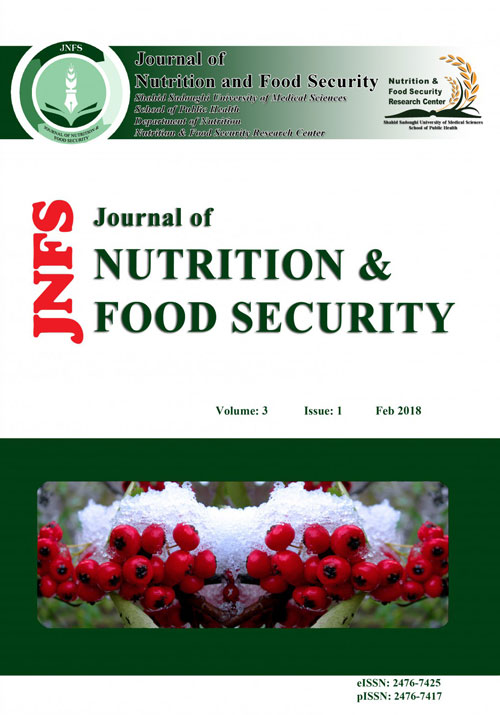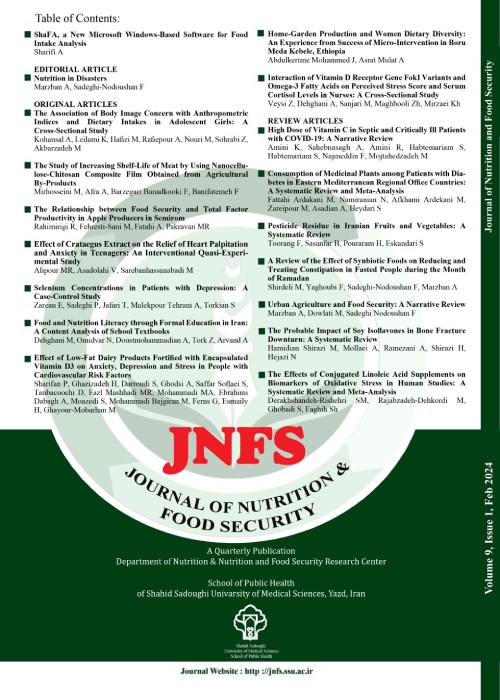فهرست مطالب

Journal of Nutrition and Food Security
Volume:3 Issue: 1, Feb 2018
- تاریخ انتشار: 1396/12/07
- تعداد عناوین: 8
-
Pages 4-12BackgroundAnxiety is a common psychological disorder that impacts on the quality of life. In recent decades, anxiety has increased, as well as obesity especially among young people. The aim of this study is to investigate the relationship between general and central obesity with anxiety among Iranian young men.MethodsThis cross-sectional study was conducted in 2016 on 246 men who were selected through cluster sampling according to the inclusion criteria. Anthropometric measurements were performed according to the standard procedure. Anxiety was assessed by DASS questionnaires with Cronbach's coefficient 0.78. In the final analysis, confounding factors were controlled and PResultsIn this study, 27% of the population had extreme anxiety and 29% had moderate anxiety. In the adjusted model, there was an inverse relationship between anxiety and central obesity (OR = 0.25, 95% CI: 0.07-0.85, P-trendConclusionsOverall central obesity and total body fat have an inverse relationship with anxiety. Prospective studies are required to confirm these associations in young populations.Keywords: Anxiety, Obesity, Total body fat, Abdominal obesity
-
Pages 13-18BackgroundWe were conducted this study to assess the prevalence of food insecurity in heart failure patients households and the relationship between food security and some variables in this households.MethodsIn this cross sectional study, a total of 300 heart failure patient's households were studied in Imam Reza hospital of Mashhad. The Iranian version of household food insecurity access scale was used to measure food security.ResultsAmong the participants in this study, 129 patients (43%) were secure, 42 patients (14%), 82 patients (27.3%) and 47 patients (15.7%) were mild, moderate and sever insecure, respectively. Chi-square test results show that there is a strong association between diabetes, hypertension, body mass index (BMI), and food security distribution (PConclusionsBased on our findings, food insecurity is mild to severe prevalent in heart failure patients households, meanwhile there is a strong relationship between diabetes, hypertension, BMI and food security status, so it is important to assess their food status and prevent from worsening their nutritional statusKeywords: Food insecurity, Heart failure, Nutrition
-
Pages 19-26BackgroundBlack spots are a major problem in commercial shrimp species and can have negative effects on shrimp's appearance, quality, shelf life, economic value, and product acceptance by consumers. This study was conducted to investigate the effect of orange peel extract on chemical and sensory qualities as well as black spots on Litopenaeus vannamei species of white farmed shrimp.MethodsSamples included treated shrimps at concentration of 150 g, orange peel extract for 30 minutes, and control shrimps. After storage for 10 days at 1 ± 4 °C, the samples chemical and sensory evaluations were performed with an interval of 5 days.ResultspH factors, peroxide value, and total volatile network (TVN) of treated samples were significantly lower compared to those of the control samples (PConclusionThe results showed that because of having antioxidant and antimicrobial activity, orange peel extract improved shrimp's chemical and sensory qualities and reduced their black spots in the refrigerator temperature.Keywords: Orange peel extract, White shrimp, Antioxidants, Black spot
-
Pages 27-32BackgroundDue to environmental contamination in recent years, contamination of food chain by heavy metals is not far-fetched. The purpose of this study is to determine heavy metals in soybeans cultivated in Iran to monitor the food chemical contaminants.MethodsTo assess metal contamination, four varieties (Sahar, Katool, Williams, and M7) of soybean cultivated in Iran, were collected. Metal concentration of samples was analyzed by inductively coupled plasma-optical emission spectrophotometer (ICP-OES).ResultsThe concentrations of Arsenic (As), Cadmium (Cd), Copper (Cu), Nickel (Ni), Lead (Pb), and Zinc (Zn) in soybean samples were ranged from 0.008 to 0.21, 0.008 to 0.16, 9.51 to 87.71, 4.08 to 22.37, 0.015 to 1.18, and 35.53 to 65.02 mg/kg, respectively. Taken together, findings of this study showed that heavy metal content of all taken samples, except Pb in M7 variety, were below the maximum limits. So, there is no need to concern about the presence of heavy metal contents in soybeans cultivated in Iran.ConclusionSince soybeans are used in production of other soy-based products (such as soy milk, soy cheese, soy sauce), regular monitoring of soybean in terms of heavy metals is necessary.Keywords: Soybean, Heavy metals, ICP-OES
-
Pages 33-39BackgroundAccording to previous studies, patient with metabolic syndrome (MetS) are different in terms of body composition from healthy subjects. The purpose of the present study was to determine the body composition of healthy obese/overweight patients and compared them with those having MetS.MethodsA case-control study was conducted on both men and women aged 20 to 55 years, who were selected using sequential sampling method, based on the inclusion and exclusion criteria, from those referred to an endocrinology and the diabetes clinic affiliated to Tehran University of Medical Sciences. One hundred and forty seven subjects were enrolled in the study and divided into three groups, including 49 with MetS, 49 obese/overweight subjects without MetS, and 49 were normal weight subjects. Body composition was measured for all subjects using bioelectrical impedance analysis. NCEP ATP III was the criterion for definition of Mets.ResultsNo significant differences were found between the study groups in terms of demographic variables. The mean of the waist circumference (WC) was higher in MetS patients (PConclusionObese/overweight patients with and without MetS had significantly higher fat mass and WC than normal weight controls, while only WC was higher in MetS group as compared with obese/overweight patients without MetS. Therefore, reduction in body fat and WC should be emphasized in patients with MetS.Keywords: Metabolic syndrome, Body composition, Obesity
-
Pages 40-50BackgroundThis study was conducted to determine the effects of n-3 PUFAs supplementation on plasma homocysteine (Hcy) level, lipid profile and insulin resistance in patients with type 2 diabetes (T2D).MethodsThis study is a double-blind controlled trial involving 70 patients with T2D selected from Yazd Diabetes Research Center in 2013. Patients were randomly assigned to receive either 2 g/day omega-3 soft gels (OG) or 2 g/day placebo (PG) for 6 weeks. At the beginning and end of the study, Hcy concentration, fasting plasma glucose (FBG), fasting plasma insulin, total cholesterol (TC), triglycerides (TG), low density lipoprotein cholesterol (LDL-c), high density lipoprotein cholesterol (HDL-c), HDL-c/LDL-c ratio, insulin resistance (HOMA-IR), insulin sensitivity (IS) and beta-cell function were measured and compared.ResultsSixty five participants completed the study. The results of this study showed that omega-3 fatty acid supplementation caused significant increase in Hcy (P = 0.007) and LDLc (P = 0.02), while HDLc and HDLc/LDLc ratio were significantly decreased (P = 0.001 and 0.006, respectively). In both groups, insulin and HOMA-IR were increased, while IS decreased significantly. Βeta-cell function was increased only in OG (P = 0.005). There was no significant difference in mean change of any factors.ConclusionThe present study found no beneficial effects of 2 g/day omega-3 supplement for 6 weeks on biomarkers of Hcy, FBG, insulin and lipid profile in th T2D patients.Keywords: Type 2 diabetes_Homocysteine_Omega-3_Lipid profiles_HOMA-IR
-
Pages 51-59BackgroundChronic kidney disease (CKD) is a progressive condition that affects many aspects of patients life with adverse outcomes of kidney failure, cardiovascular disease (CVD), and premature death. Malnutrition is a relatively common problem in these patients that may be the result of inadequate intake, increased catabolism, or loss of nutrients in the dialysis. The aim of this study was to review the nutritional status and requirements of CKD patients in Iran using previous studies.MethodsSearch engines including PubMed, Scopus, Embase, Science Direct, Google scholar, Magiran, and scientific information database (SID) were applied with keywords such as chronic kidney disease, malnutrition, renal disease, end stage renal disease, nutritional deficiency, malnutrition, quality of life, vitamin deficiency, wasting, and Iran to find related articles published up to 2016.ResultsThe persistence of malnutrition increases susceptibility to infectious and cardiovascular diseases, delays wound healing, and finally increases morbidity and mortality.ConclusionConsidering the importance of nutritional status in patients with chronic kidney disease, it is necessary to design and development of more effective strategies to optimize nutritional status of these patients.Keywords: Chronic kidney diseases, Renal disease, Chronic renal insufficiency, Malnutrition, Nutritional deficiency


